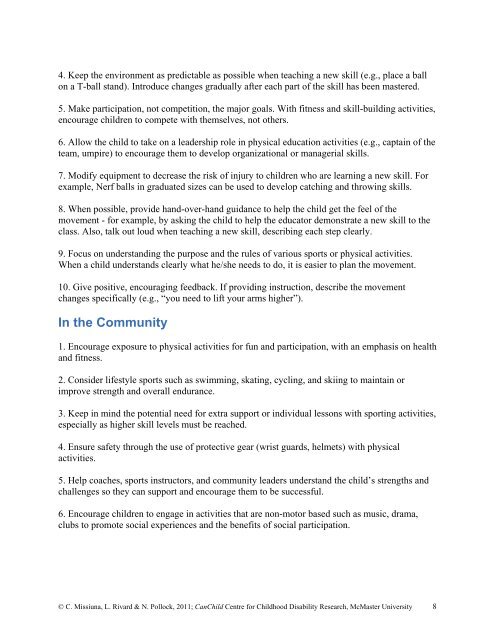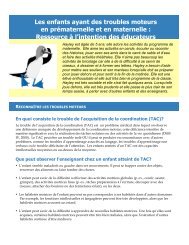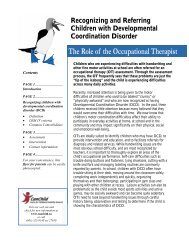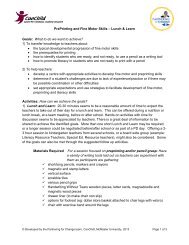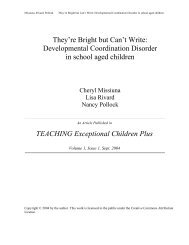Children with Developmental Coordination Disorder - CanChild ...
Children with Developmental Coordination Disorder - CanChild ...
Children with Developmental Coordination Disorder - CanChild ...
Create successful ePaper yourself
Turn your PDF publications into a flip-book with our unique Google optimized e-Paper software.
4. Keep the environment as predictable as possible when teaching a new skill (e.g., place a ballon a T-ball stand). Introduce changes gradually after each part of the skill has been mastered.5. Make participation, not competition, the major goals. With fitness and skill-building activities,encourage children to compete <strong>with</strong> themselves, not others.6. Allow the child to take on a leadership role in physical education activities (e.g., captain of theteam, umpire) to encourage them to develop organizational or managerial skills.7. Modify equipment to decrease the risk of injury to children who are learning a new skill. Forexample, Nerf balls in graduated sizes can be used to develop catching and throwing skills.8. When possible, provide hand-over-hand guidance to help the child get the feel of themovement - for example, by asking the child to help the educator demonstrate a new skill to theclass. Also, talk out loud when teaching a new skill, describing each step clearly.9. Focus on understanding the purpose and the rules of various sports or physical activities.When a child understands clearly what he/she needs to do, it is easier to plan the movement.10. Give positive, encouraging feedback. If providing instruction, describe the movementchanges specifically (e.g., “you need to lift your arms higher”).In the Community1. Encourage exposure to physical activities for fun and participation, <strong>with</strong> an emphasis on healthand fitness.2. Consider lifestyle sports such as swimming, skating, cycling, and skiing to maintain orimprove strength and overall endurance.3. Keep in mind the potential need for extra support or individual lessons <strong>with</strong> sporting activities,especially as higher skill levels must be reached.4. Ensure safety through the use of protective gear (wrist guards, helmets) <strong>with</strong> physicalactivities.5. Help coaches, sports instructors, and community leaders understand the child’s strengths andchallenges so they can support and encourage them to be successful.6. Encourage children to engage in activities that are non-motor based such as music, drama,clubs to promote social experiences and the benefits of social participation.© C. Missiuna, L. Rivard & N. Pollock, 2011; <strong>CanChild</strong> Centre for Childhood Disability Research, McMaster University 8


